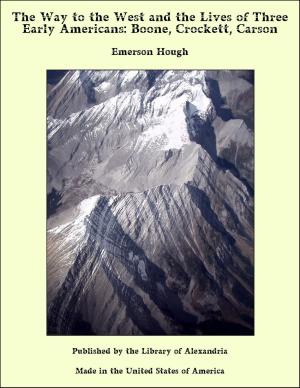The World Before the Deluge
Nonfiction, Religion & Spirituality, New Age, History, Fiction & Literature| Author: | Louis Figuier | ISBN: | 9781465611413 |
| Publisher: | Library of Alexandria | Publication: | March 8, 2015 |
| Imprint: | Language: | English |
| Author: | Louis Figuier |
| ISBN: | 9781465611413 |
| Publisher: | Library of Alexandria |
| Publication: | March 8, 2015 |
| Imprint: | |
| Language: | English |
The observer who glances over a rich and fertile plain, watered by rivers and streams which have, during a long series of ages, pursued the same uniform and tranquil course; the traveller who contemplates the walls and monuments of a great city, the first founding of which is lost in the night of ages, testifying, apparently, to the unchangeableness of things and places; the naturalist who examines a mountain or other locality, and finds the hills and valleys and other accidents of the soil in the very spot and condition in which they are described by history and tradition—none of these observers would at first suspect that any serious change had ever occurred to disturb the surface of the globe. Nevertheless, the earth has not always presented the calm aspect of stability which it now exhibits; it has had its convulsions, and its physical revolutions, whose story we are about to trace. The earth, like the body of an animal, is wasted, as the philosophical Hutton tells us, at the same time that it is repaired. It has a state of growth and augmentation; it has another state, which is that of diminution and decay: it is destroyed in one part to be renewed in another; and the operations by which the renewal is accomplished are as evident to the scientific eye as those by which it is destroyed. A thousand causes, aqueous, igneous, and atmospheric, are continually at work modifying the external form of the earth, wearing down the older portions of its surface, and reconstructing newer out of the older; so that in many parts of the world denudation has taken place to the extent of many thousand feet. Buried in the depths of the soil, for example, in one of those vast excavations which the intrepidity of the miner has dug in search of coal or other minerals, there are numerous phenomena which strike the mind of the inquirer, and carry their own conclusions with them. A striking increase of temperature in these subterranean places is one of the most remarkable of these. It is found that the temperature of the earth rises one degree for every sixty or seventy feet of descent from its surface. Again: if the mine be examined vertically, it is found to consist of a series of layers or beds, sometimes horizontal, but more frequently inclined, upright, or contorted and undulating—even folded back upon themselves. Then, instances are numerous where horizontal and parallel beds have been penetrated, and traversed vertically or obliquely by veins of ores or minerals totally different in their appearance and nature from the surrounding rocks. All these undulations and varying inclinations of strata are indications that some powerful cause, some violent mechanical action, has intervened to produce them. Finally, if the interior of the beds be examined more minutely—if, armed with the miner’s pick and hammer, the rock is carefully broken up—it is not impossible that the very first efforts at mining may be rewarded by the discovery of some fossilised organic form no longer found in the living state. The remains of plants and animals belonging to the earlier ages of the world, are, in fact, very common; entire strata are sometimes formed of them; and in some localities the rocks can scarcely be disturbed without yielding fragments of bones and shells, or the impressions of fossilised animals and vegetables—the buried remains of extinct creations.
The observer who glances over a rich and fertile plain, watered by rivers and streams which have, during a long series of ages, pursued the same uniform and tranquil course; the traveller who contemplates the walls and monuments of a great city, the first founding of which is lost in the night of ages, testifying, apparently, to the unchangeableness of things and places; the naturalist who examines a mountain or other locality, and finds the hills and valleys and other accidents of the soil in the very spot and condition in which they are described by history and tradition—none of these observers would at first suspect that any serious change had ever occurred to disturb the surface of the globe. Nevertheless, the earth has not always presented the calm aspect of stability which it now exhibits; it has had its convulsions, and its physical revolutions, whose story we are about to trace. The earth, like the body of an animal, is wasted, as the philosophical Hutton tells us, at the same time that it is repaired. It has a state of growth and augmentation; it has another state, which is that of diminution and decay: it is destroyed in one part to be renewed in another; and the operations by which the renewal is accomplished are as evident to the scientific eye as those by which it is destroyed. A thousand causes, aqueous, igneous, and atmospheric, are continually at work modifying the external form of the earth, wearing down the older portions of its surface, and reconstructing newer out of the older; so that in many parts of the world denudation has taken place to the extent of many thousand feet. Buried in the depths of the soil, for example, in one of those vast excavations which the intrepidity of the miner has dug in search of coal or other minerals, there are numerous phenomena which strike the mind of the inquirer, and carry their own conclusions with them. A striking increase of temperature in these subterranean places is one of the most remarkable of these. It is found that the temperature of the earth rises one degree for every sixty or seventy feet of descent from its surface. Again: if the mine be examined vertically, it is found to consist of a series of layers or beds, sometimes horizontal, but more frequently inclined, upright, or contorted and undulating—even folded back upon themselves. Then, instances are numerous where horizontal and parallel beds have been penetrated, and traversed vertically or obliquely by veins of ores or minerals totally different in their appearance and nature from the surrounding rocks. All these undulations and varying inclinations of strata are indications that some powerful cause, some violent mechanical action, has intervened to produce them. Finally, if the interior of the beds be examined more minutely—if, armed with the miner’s pick and hammer, the rock is carefully broken up—it is not impossible that the very first efforts at mining may be rewarded by the discovery of some fossilised organic form no longer found in the living state. The remains of plants and animals belonging to the earlier ages of the world, are, in fact, very common; entire strata are sometimes formed of them; and in some localities the rocks can scarcely be disturbed without yielding fragments of bones and shells, or the impressions of fossilised animals and vegetables—the buried remains of extinct creations.















